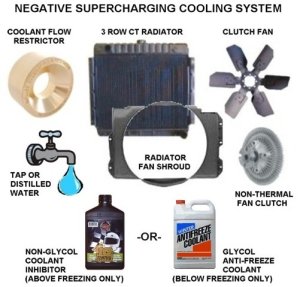| Negative
Supercharging Cooling System
Keeps the water temperature
below 50°C (122°F) with hot air induction
by using a special coolant flow restrictor and a
unique combination of conventional cooling system
parts that may already be fitted to the vehicle

|
Negative Supercharging
Cooling System comprises of...
- Coolant Flow Restrictor
- 3 Row Cellular Tubular Radiator
- NON-Thermal Fan Clutch
- Clutch Fan
- Radiator Fan Shroud
- NON-Glycol Coolant Inhibitor ABOVE freezing
-or- Glycol Anti-Freeze Coolant BELOW freezing
only
- Tap or Distilled Water
Negative
Supercharging Cooling System Specs |
How the Negative Supercharging
Cooling System works
The Negative Supercharging Cooling System uses a low
flow technique that circulates the water 5 times slower
than conventional high flow cooling systems to keep
the water temperature below 50°C (122°F).
The low flow technique is produced by a special coolant
flow restrictor with a small tapered hole that produces
the optimum coolant flow rate of 23 L/min (5 gpm)
from idle to peak rpm. In other words the Negative
Supercharging Cooling System circulates the entire
cooling system once every 35 seconds from idle to
peak rpm. Compared to conventional high flow cooling
systems, they circulate the entire cooling system
once every 14 seconds at 2000rpm which increases to
once every 5 seconds at 5000 rpm. This circulates
the water through the radiator too fast which allows
the hot water to flow back into the engine before
the air flow can draw most of the heat from the radiator.
The low flow technique keeps the water in the radiator for a much longer period of time which allows the air flow to draw a lot more heat from the radiator. This substantially reduces the water temperature and keeps it below 50°C (122°F) even at high speeds due to the fact that, 1) cold water absorbs and releases a lot more heat than hot water and 2) the higher air flow through the radiator at high speeds draws a lot more heat from slower coolant flow. Therefore, if the water flows faster or slower than the optimum flow rate of 23 L/min (5 gpm), it substantially increases the water temperature above 50°C (122°F).
However, for the low flow technique to work effectively
in keeping the water temperature below 50°C
(122°F) it must be used with the following parts
and coolant.
- 3 Row Radiator - draws more heat from
the slow flowing coolant with its larger cooling
surface area
- NON-Thermal Fan Clutch and Fan - maintains
a constant air flow through the radiator at all
times
- Radiator Fan Shroud - maximises the air
flow through the radiator at idle and low speeds
- Tap or Distilled Water - maximises heat
transfer
- NON-Glycol Coolant Inhibitor - prevents
corrosion and maximises heat transfer above freezing
Engine runs hot with cold
water
The water in the coolant passages of the engine absorb
heat from the combustion chamber and cylinder walls
to maintain the optimum combustion temperature and
prevent the engine from overheating whether the water
is hot or cold. However, cold water absorbs a lot
more heat than hot water. Therefore, by circulating
cold water through the coolant passages it absorbs
more heat from the hotter combustion produced by Negative
Pressure Supercharging and hot air induction. The
cold water prevents the hotter combustion from exceeding
the optimum temperature and overheating the engine
while allowing the cylinders, combustion chamber,
valves, pistons, rings, crank and oil to operate at
the normal hot temperature. The ONLY part of the engine
that runs cold with Negative Pressure Supercharging
is the water in the coolant passages.
For example,
- The engine runs so hot with Negative Pressure
Supercharging and cold water that, a) the engine
uses spark plugs 5 steps colder than standard
to prevent pre-ignition with the hotter combustion
and b) when the engine is turned-off, the hotter
combustion chamber causes the water temperature
to suddenly increase by 35°C (63°F) from
50-85°C (122-185°F).
- The Negative Supercharging Cooling System is
so efficient at keeping the water cold with Negative
Pressure Supercharging and hot air induction that
when the engine is turned-off, the hotter combustion
chamber causes the water temperature to suddenly
increase by 35°C (63°F) from 50-85°C
(122-185°F). However, when the engine is re-started
the water temperature immediately reduces to the
optimum 50°C (122°F) operating temperature.
Negative Supercharging Cooling
System does NOT need...
 |
Thermostat |
 |
High flow cooling system |
 |
High flow water pump |
 |
Complex plumbing |
 |
Expensive plumbing |
 |
Expensive chemical coolant |
For example,
- High flow water pumps and cooling systems circulate
the water too fast through the radiator. This
allows hot water to flow back into the engine
before the air flow can draw most of the heat
from the radiator which prevents the water from
running this cold.
- Chemical coolant that prevents vapour bubbles
from forming to improve heat
transfer in hot water does NOT work with the
colder water temperature produced by the Negative
Supercharging Cooling System. This is because
the water temperature is too cold to form vapour
bubbles and this type of chemical coolant is very
poor at transferring heat at colder coolant temperatures
compared to water.
Heat transfer is the efficiency
of a liquid to absorb and release heat
Water has a very high specific heat, which means it
absorbs and releases a lot more heat produced by combustion
than all other liquids. For example, adding other
liquids to water in large volumes, such as Glycol
anti-freeze, reduces the efficiency of water to transfer
heat the larger the volume added to the water which
reduces the efficiency of the cooling system which
causes overheating problems during hot weather.
| Impulse Engine Technology
P/L |
PO Box 986 Randwick NSW 2031 Australia
Ph: (02) 9398 5544
Fax: (02) 9398 5644
International: Ph: +(612) 9398 5544
Fax: +(612) 9398 5644
Email Us
Inventor of Negative Pressure Supercharging
|
|


